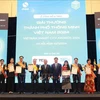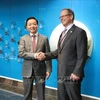Developing an information technology (IT) workforce of international standard is one of six key missions to forge Vietnam into a strong country in IT and communications.
By 2015, the country aims to have 30 percent of graduates in IT, electronics and telecommunications qualified for the international labour market. By 2020, this rate will be 80 percent and the total number of IT workforce will reach one million people.
At a meeting in the first quarter of this year, Minister of Information and Communications Le Doan Hop pointed out that fresh IT graduates are still weak in foreign languages skills as well as soft skills in presentation, updates on latest technologies, independence and teamwork.
Sharing the same views, Nguyen Thuong Hai, Intel’s education manager in Vietnam said the gap between employers’ requirements and graduates’ qualifications remains considerable.
Vu Tuan Lam, Head of the Institute of Post , Science and Technology under the Posts and Telecommunications Institute of Technology said a combination of training with research and business is the most effective way to develop a high standard IT workforce.
Le Truong Tung, Rector of the FPT University proposed that the government should provide financial incentives to develop the IT workforce, including scholarships to students and preferential taxes and loans to investors in training IT.
Phi Dac Hai, Rector of the Vietnam Korea Friendship Information Technology College said the curriculum should focus on practices, adding that the State should fund expenses of upgraded classrooms, equipment for practical purposes and Internet for key universities.
According to the Deputy Minister of Information and Communications, Tran Duc Lai, domestic IT businesses are forecast to be in need of 554,000 workers by 2015, with half of them graduating from universities. While by 2020, there will be a shortage of 10 million workers in the global IT labour market, which provides a great chance for Vietnam to capture a share of this growing market./.
By 2015, the country aims to have 30 percent of graduates in IT, electronics and telecommunications qualified for the international labour market. By 2020, this rate will be 80 percent and the total number of IT workforce will reach one million people.
At a meeting in the first quarter of this year, Minister of Information and Communications Le Doan Hop pointed out that fresh IT graduates are still weak in foreign languages skills as well as soft skills in presentation, updates on latest technologies, independence and teamwork.
Sharing the same views, Nguyen Thuong Hai, Intel’s education manager in Vietnam said the gap between employers’ requirements and graduates’ qualifications remains considerable.
Vu Tuan Lam, Head of the Institute of Post , Science and Technology under the Posts and Telecommunications Institute of Technology said a combination of training with research and business is the most effective way to develop a high standard IT workforce.
Le Truong Tung, Rector of the FPT University proposed that the government should provide financial incentives to develop the IT workforce, including scholarships to students and preferential taxes and loans to investors in training IT.
Phi Dac Hai, Rector of the Vietnam Korea Friendship Information Technology College said the curriculum should focus on practices, adding that the State should fund expenses of upgraded classrooms, equipment for practical purposes and Internet for key universities.
According to the Deputy Minister of Information and Communications, Tran Duc Lai, domestic IT businesses are forecast to be in need of 554,000 workers by 2015, with half of them graduating from universities. While by 2020, there will be a shortage of 10 million workers in the global IT labour market, which provides a great chance for Vietnam to capture a share of this growing market./.



















